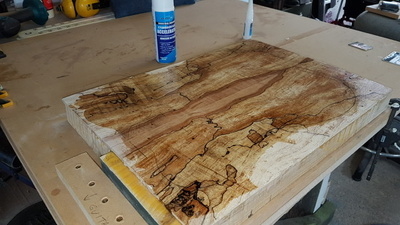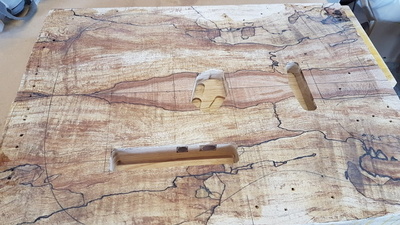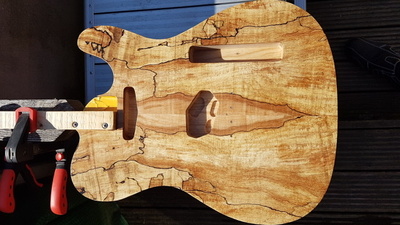Hello all,
New to this forum and guitar building. I've been working on a thinline telecaster build for sometime now. The build consists of a Utile back and 6mm maple cap. I've stained the top and now in the process of applying the finish.
I did notice during the build that the maple cap was easily marked and hoped that the finish would help toughen the surface.
I'm using Crimson guitar's finishing oil. I've applied somewhere in the region of 15 thin coats, at a rate of 1 every other day but the top is still really prone to marking. Just running a nail (finger nail) is enough to dent the surface.
Any suggestions would be gratefully received.
I'm using Crimson guitar's finishing oil.
@mrsmurfy I haven’t used this oil personally but I have a friend who has and he says it’s not good. Both of us have used other oils such as Danish Oil and Tru Oil (my favourite). He decided to give the Crimson oil a try, just to try something new. He didn’t like at all and said he was reverting back to Tru Oil. I trust his judgement so I will not be buying any. If I were you, I would buy some Tru Oil and proceed with that, it produces a lovely lustre.
Make guitars, not war 🌍✌️🎸
Thanks John, I will give the Tru Oil a go. The Crimson guitar oil does seem to take a lot longer to cure than they suggest. If you put more than one coat on a day it starts to get really tacky and you then have to wait days to apply anymore. I imagine Tru oil will be compatible with the Crimson guitar products, so I don't have to sand back.
Do you have any thoughts on the softness I'm seeing in the maple? I can easily be dented with my nail. I was hoping that the cure oiled surface would provide some resistance to this.
Thanks Again.
Andy
I used Liberon Finishing Oil on my home builds as recommended by Mark - you can do two or three coats a day - takes 5 or more coats to get a decent sheen - apply, wait for 10 and wipe off any excess, revisit every so often and wipe any spots then re-apply after three or four hours on a reasonably wam day.
A coat of micro-crystalline wax give a soft shine......
Measure once........ Measure again......... Sod it - make tea!
Hi Smurfy,
there isn't really any finish, especially oil based, which is actually going to strengthen the surface or structure of the wood. If it is soft it will remain so, ask anyone who has made an acoustic guitar with a cedar top! Depending on just how soft the wood is you could try soaking it with thin superglue and then spraying with activator. That might help but whether this is an option now that you have oiled the surface I really don't know, probably not. Maybe this one is just going to be a guitar which achieve 'distressed antique' status quicker than you had planned!
I did notice during the build that the maple cap was easily marked and hoped that the finish would help toughen the surface.
That's the first interesting comment.
Maple, being a light coloured wood, is perhaps more prone to picking up visible marks in a workshop, but it's also - or should be - a relatively hard wood, so I'm confused as to why you'd want or need to "toughen" the surface.
Most finishes will only protect the surface, they won't make the underlying material inherently tougher.
I'm using Crimson guitar's finishing oil.
I've used that as well - with no issues and some great results.
I've also used Liberon / Tru-oil / Danish oil and many other variations on that theme. They all have some slight differences in how best to apply them, how quickly subsequently coats can be applied, etc.
There are videos available on Crimson's YT channel that illustrate how they recommend to apply their stains/oils. Light coats, rub on, wipe off, leave to dry. IIRC, they just use paper towels to apply the finish, and that seems to work for them.
Online guitar making courses – guitarmaking.co.uk
I've applied somewhere in the region of 15 thin coats
15?????
That is way more - 3x or even 5x more - than I've ever needed to apply.
It depends on the environment in which the guitar is left after you've applied the finish, but it takes a period to dry/harden. If you apply another coat *before* the previous coat has completely hardened, then I think you end up an ever thickening layer (or, in this case, 15 layers) of oil which will *never* properly harden.
I've found that the first coats harden pretty quickly - probably less than a day - but you have to wait until its completely non-tacky *before* applying the next coat, and as you add more coats, it takes longer to harden, so you need to wait longer.
To be brutal, if you've got 15 coats of oil on it, you're probably going to need to remove the oil, get back to bare wood, and start over.
Online guitar making courses – guitarmaking.co.uk
Final thought (it's a pain not being able to edit previous posts!)
Oil is never going to give as hard and protective a finish as some other products. IF you paint (yuk) or lacquer a guitar, that'll give it more protection against slight dings, *but* once you've broken that type of finish, a repair is more difficult.
Plus, an oiled finish means you can still "feel" the wood of the guitar, rather than being insulated from it by layers of product!
Scratches on oiled finishes are easy to repair - rub down (lightly) and re-apply the oil.
Some people prefer to wax over the top of an oiled finish to give a bit more protection, but I've never managed to get that feeling quite right.
Online guitar making courses – guitarmaking.co.uk
It is sounding like you have some Spalted Maple, it’s quite spongy and inconsistent. To stabilise it there are different products and methods. One I have used is thin ca (super glue) glue, to do a ca flood. It is exactly how it sounds, you flood the surface and it soaks in, spray it with ca accelerator and then flood it again and repeat. This will set rock hard. I’m not sure how far into the Spalted maple it penetrates but I would guess it’s more than with a standard piece of maple. You then have to sand it all flat and it leaves a flat, stable, consistent surface to work with. That was my method and my experience of stabilising Spalted maple. I think that what makes maple (or any wood) Spalted, is that a fungus grows into the wood by eating the sugar in the sap wood, therefore destabilising the fibrous structure of the wood (someone correct me if I’m wrong). Some parts of it are a lot softer than others and it will just soak up whatever you throw at it. I think the ca glue method will strengthen and make it consistent but using oil will not. Epoxy resin is another way to stabilise but I haven’t tried that yet. I suspect it will work just as well as it goes rock solid when fully cured.
Make guitars, not war 🌍✌️🎸








